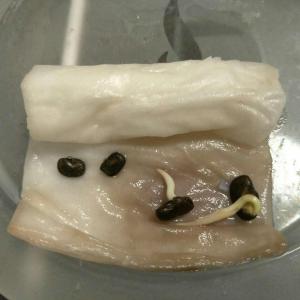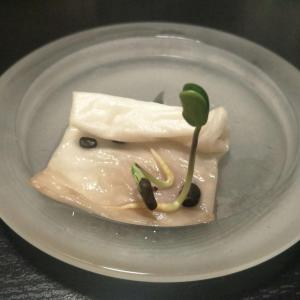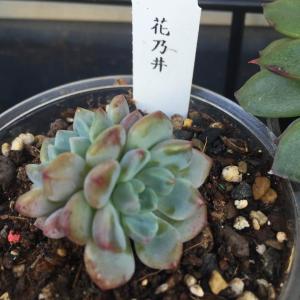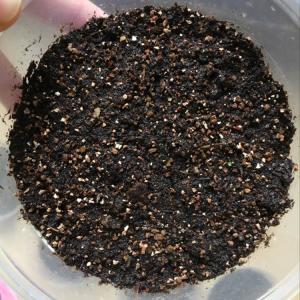Aki
2018年01月12日

Got this Anchan or butterfly pea flower seeds from my nephew, the progress of growing from seed on 10 Jan - 12 Jan




0
0
文章
Miss Chen
2018年01月10日

Description: This perennial plant is 3-12' tall. Plants in dense colonies are only 3-5' tall, but 'lone wolf' plants can achieve considerable height. The stout central stem is glabrous, glaucous, terete (circular in cross-section), and often reddish or reddish-purple in color. There is very little branching, except for some flowering stems that occur along the upper half of the plant. The leaves are up to 8" long and 2½" across, lanceolate-oblong, and either smooth (entire) or slightly to strongly serrate along their margins. The upper leaf surface is medium to dark green with a sandpapery texture that derives from the presence of minute stiff hairs. The lower leaf surface is pale green and softly hairy. The leaves are often slightly recurved, and they have a tendency to fold upward along their central veins, particularly during hot dry weather. The leaves are opposite below, but they become either alternate or opposite along the upper half of the plant. The leaves taper gradually into slender petioles that are about ½" in length.
The upper stems terminate into either individual or small clusters of flowerheads. Each flowerhead is 2½-4" across, consisting of 10-20 ray florets that surround numerous disk florets. The tiny corollas of the disk florets are tubular-shaped and yellow, while the petaloid rays along the circumference of the flowerhead are bright yellow and oblong in shape. Around the base of each flowerhead, there are floral bracts (phyllaries) that are arranged in several overlapping series. These bracts are light green and linear-lanceolate in shape, becoming slightly recurved when the flowerhead blooms. On a large plant, it is not uncommon for several flowerheads to be bloom at the same time. The blooming period occurs from late summer to fall, lasting about 1-2 months. The disk florets are replaced by achenes about 3-4 mm. in length that are oblongoid and somewhat flattened in shape. The root system is fibrous and rhizomatous, often forming clonal colonies of variable size.
Cultivation: The preference is full sun, moist soil, and fertile loamy soil with high organic content. However, this robust plant will tolerated other kinds of soil. Powdery mildew may affect the leaves, but this typically occurs during the fall after the blooming period. Strong wind can cause this plant to blow over in exposed situations. It also requires lots of room because of its large (sometimes huge) size and aggressive tendencies.

Range & Habitat: The native Sawtooth Sunflower occurs throughout most of Illinois, except for a few SE counties (see Distribution Map). It is a common plant. Habitats include moist to mesic black soil prairies, thickets, moist meadows near rivers or lakes, Bur Oak savannas, bases of bluffs, fence rows, and areas along ditches, railroads, and roadsides. Sawtooth Sunflower thrives in both disturbed and high quality sites, sometimes forming large colonies that exclude other plants.
Faunal Associations: The most common visitors to the flowers are bees, especially long-tongued species. Among these are honeybees, bumblebees, Cuckoo bees (Epeolus spp., Triepeolus spp.), digger bees (Melissodes spp.), and leaf-cutting bees (Megachile spp.). Other insect visitors include Syrphid flies, bee flies, butterflies, moths, and beetles. Both nectar and pollen are available as floral rewards. Other insects feed on the foliage, plant juices, pith of stems, developing seeds, etc., of sunflowers. These insect feeders include caterpillars of the butterflies Chlosyne nycteis (Silvery Checkerspot) and Chlosyne gorgone (Gorgone Checkerspot), stem-boring caterpillars of Papaipema necopina (Sunflower Borer Moth) and Papaipema rigida (Rigid Sunflower Borer Moth), seed-eating caterpillars of the moths Homoeosoma electella (Sunflower Moth) and Stibadium spumosum (Frothy Moth), foliage-eating caterpillars of Grammia arge (Arge Tiger Moth) and Phragmatobia fuliginosa (Ruby Tiger Moth), and many other Lepidoptera (see Lepidoptera Table for a more complete listing of these species).

Other insect feeders of sunflowers include the stem-boring larvae of Apion occidentale (Black Sunflower Weevil) and Cylindrocopturus adspersus (Sunflower Stem Weevil), Physonota helianthi (Sunflower Tortoise Beetle) and Systena blanda (Pale-Striped Flea Beetle), larvae of the flies Neotephritis finalis (Sunflower Seed Maggot) and Strauzia longipennis (Sunflower Maggot), Hesperotettix viridis (Meadow Purple-Striped Grasshopper) and Melanoplus femurrubrum (Red-Legged Grasshopper), Aphis helianthi (Sunflower Aphid) and Uroleucon ambrosiae (Brown Ambrosia Aphid), Clastoptera xanthocephala (Sunflower Spittlebug), and many other insects (see Insect Table for a more complete listing of these species). The seeds of sunflowers are a favorite food of such upland gamebirds and songbirds as the Ring-Necked Pheasant, Bobwhite Quail, Mourning Dove, Redwing Blackbird, Eastern Goldfinch, Lark Sparrow, and Savannah Sparrow. Such rodents as the Franklin Ground Squirrel, Prairie Vole, and Meadow Vole also eat the seeds. These animals probably help to spread the seeds into new areas. When the Sawtooth Sunflower and other sunflowers are located near bodies of water, beavers and muskrats sometimes use their stems to construct dams or lodges. Deer, cattle, and other hoofed mammalian herbivores occasionally browse on the foliage of larger sunflower plants, while groundhogs and rabbits are more likely to attack smaller plants.

Photographic Location: The photographs were taken at the Red Bison Railroad Prairie in Savoy, Illinois, and Meadowbrook Park in Urbana, Illinois.
Comments: Notwithstanding its name, the Sawtooth Sunflower often has leaves that are toothless or only slightly serrated. There is considerable variation in the size of plants across different locations, and the leaves are somewhat variable in their size and shape. This sunflower can be distinguished from other Helianthus spp. (sunflowers) by its smooth reddish stems, which often have a powdery white bloom that can rubbed off (i.e., they are glabrous and glaucous). The lower stems on large older plants can become slightly woody in appearance. The Sawtooth Sunflower is similar in size and appearance to Helianthus giganteus (Giant Sunflower), but this latter species has hairy stems and it is usually found in habitats that are more moist and sandy.
The upper stems terminate into either individual or small clusters of flowerheads. Each flowerhead is 2½-4" across, consisting of 10-20 ray florets that surround numerous disk florets. The tiny corollas of the disk florets are tubular-shaped and yellow, while the petaloid rays along the circumference of the flowerhead are bright yellow and oblong in shape. Around the base of each flowerhead, there are floral bracts (phyllaries) that are arranged in several overlapping series. These bracts are light green and linear-lanceolate in shape, becoming slightly recurved when the flowerhead blooms. On a large plant, it is not uncommon for several flowerheads to be bloom at the same time. The blooming period occurs from late summer to fall, lasting about 1-2 months. The disk florets are replaced by achenes about 3-4 mm. in length that are oblongoid and somewhat flattened in shape. The root system is fibrous and rhizomatous, often forming clonal colonies of variable size.
Cultivation: The preference is full sun, moist soil, and fertile loamy soil with high organic content. However, this robust plant will tolerated other kinds of soil. Powdery mildew may affect the leaves, but this typically occurs during the fall after the blooming period. Strong wind can cause this plant to blow over in exposed situations. It also requires lots of room because of its large (sometimes huge) size and aggressive tendencies.

Range & Habitat: The native Sawtooth Sunflower occurs throughout most of Illinois, except for a few SE counties (see Distribution Map). It is a common plant. Habitats include moist to mesic black soil prairies, thickets, moist meadows near rivers or lakes, Bur Oak savannas, bases of bluffs, fence rows, and areas along ditches, railroads, and roadsides. Sawtooth Sunflower thrives in both disturbed and high quality sites, sometimes forming large colonies that exclude other plants.
Faunal Associations: The most common visitors to the flowers are bees, especially long-tongued species. Among these are honeybees, bumblebees, Cuckoo bees (Epeolus spp., Triepeolus spp.), digger bees (Melissodes spp.), and leaf-cutting bees (Megachile spp.). Other insect visitors include Syrphid flies, bee flies, butterflies, moths, and beetles. Both nectar and pollen are available as floral rewards. Other insects feed on the foliage, plant juices, pith of stems, developing seeds, etc., of sunflowers. These insect feeders include caterpillars of the butterflies Chlosyne nycteis (Silvery Checkerspot) and Chlosyne gorgone (Gorgone Checkerspot), stem-boring caterpillars of Papaipema necopina (Sunflower Borer Moth) and Papaipema rigida (Rigid Sunflower Borer Moth), seed-eating caterpillars of the moths Homoeosoma electella (Sunflower Moth) and Stibadium spumosum (Frothy Moth), foliage-eating caterpillars of Grammia arge (Arge Tiger Moth) and Phragmatobia fuliginosa (Ruby Tiger Moth), and many other Lepidoptera (see Lepidoptera Table for a more complete listing of these species).

Other insect feeders of sunflowers include the stem-boring larvae of Apion occidentale (Black Sunflower Weevil) and Cylindrocopturus adspersus (Sunflower Stem Weevil), Physonota helianthi (Sunflower Tortoise Beetle) and Systena blanda (Pale-Striped Flea Beetle), larvae of the flies Neotephritis finalis (Sunflower Seed Maggot) and Strauzia longipennis (Sunflower Maggot), Hesperotettix viridis (Meadow Purple-Striped Grasshopper) and Melanoplus femurrubrum (Red-Legged Grasshopper), Aphis helianthi (Sunflower Aphid) and Uroleucon ambrosiae (Brown Ambrosia Aphid), Clastoptera xanthocephala (Sunflower Spittlebug), and many other insects (see Insect Table for a more complete listing of these species). The seeds of sunflowers are a favorite food of such upland gamebirds and songbirds as the Ring-Necked Pheasant, Bobwhite Quail, Mourning Dove, Redwing Blackbird, Eastern Goldfinch, Lark Sparrow, and Savannah Sparrow. Such rodents as the Franklin Ground Squirrel, Prairie Vole, and Meadow Vole also eat the seeds. These animals probably help to spread the seeds into new areas. When the Sawtooth Sunflower and other sunflowers are located near bodies of water, beavers and muskrats sometimes use their stems to construct dams or lodges. Deer, cattle, and other hoofed mammalian herbivores occasionally browse on the foliage of larger sunflower plants, while groundhogs and rabbits are more likely to attack smaller plants.

Photographic Location: The photographs were taken at the Red Bison Railroad Prairie in Savoy, Illinois, and Meadowbrook Park in Urbana, Illinois.
Comments: Notwithstanding its name, the Sawtooth Sunflower often has leaves that are toothless or only slightly serrated. There is considerable variation in the size of plants across different locations, and the leaves are somewhat variable in their size and shape. This sunflower can be distinguished from other Helianthus spp. (sunflowers) by its smooth reddish stems, which often have a powdery white bloom that can rubbed off (i.e., they are glabrous and glaucous). The lower stems on large older plants can become slightly woody in appearance. The Sawtooth Sunflower is similar in size and appearance to Helianthus giganteus (Giant Sunflower), but this latter species has hairy stems and it is usually found in habitats that are more moist and sandy.
0
0




















